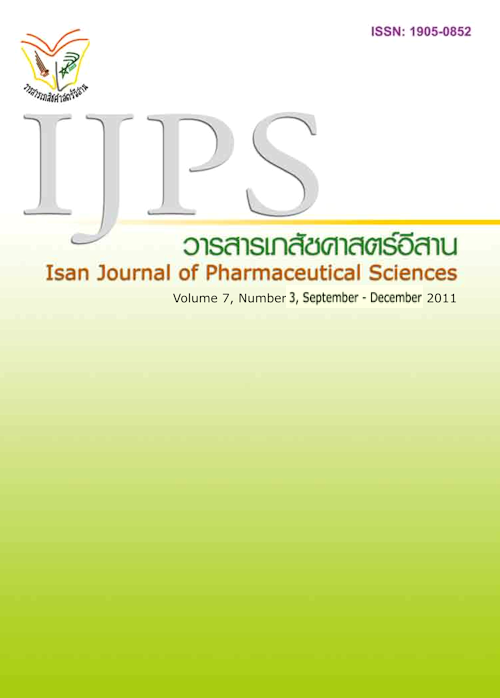The development of phenytoin sodium controlled release tablet
Main Article Content
Abstract
Introduction: Phenytoin is an anticonvulsant drug with narrow therapeutic range. It is a weak acid which makes it practically insoluble in water. Phenytoin sodium formulation is developed in order to increase the solubility. Taking phenytoin sodium orally or in acid conditions will result in converting phenytoin sodium to phenytoin free acid and will cause low absorption and fuctuation of plasma drug concentration. Objective: To develop mini-tablet phenytoin sodium multiple unit dosage forms. The phenytoin formulation was designed to release in the stomach, small intestine and large intestine. The pH adjusted material was added to the tablet to control the pH of the diffusion layer around the tablet higher than the pKa (8.3). This would increase the solubility of phenytoin sodium in the stomach and intestine. Materials and methods: Development of phenytoin sodium mini-tablets was performed. Each tablet contained 25 mg phenytoin sodium, fller, lubricant, and sodium bicarbonate in various concentrations as the pH adjusting agent in the tablet to protect converting of phenytoin sodium to phenytoin free acid and improve solubility in intestinal conditions. Some of the mini-tablets were coated with Coteric® L 100 to control drug release in small intestine and some were coated with Polycoat® S 100 to control drug release in large intestine. Mini-tablets were evaluated by USP and BP guidelines such as hardness, friability, weight variation, disintegration time, content uniformity, and dissolution testing. The mini-tablets were flled in capsules with ratio of uncoated: Coteric®L 100 coated: Polycoat®S 100 coated 1: 2: 1 and dissolution tested in 0.1 N HCl for 2 hrs, pH 6.8 phosphate buffer for 3 hrs, pH 7.4 phosphate buffer for 2 hrs. Results: The mini-tablets in formulas 1, 2, and 3 had an average weight 50.69, 50.94, and 50.98 mg respectively. The percentages of friability were 0.62, 0.28, and 0.57 respectively. The content uniformities were 97.30±1.66, 97.33±1.79, and 97.84±3.49 respectively. Drug releases from dissolution testing in 0.1 N HCl were 25.54, 23.41, and 22.01%, in pH 6.8 phosphate buffer were 71.57, 50.15, and 41.90%, and in pH 7.4 phosphate buffer were 91.55, 67.26, and 55.02% respectively. Conclusion: The product can release the active ingredient at acid, pH 6.8 phosphate buffer and pH 7.4 phosphate buffer as designed. However the higher the sodium bicarbonate level, the lower the release of active ingredient.
Article Details
In the case that some parts are used by others The author must Confirm that obtaining permission to use some of the original authors. And must attach evidence That the permission has been included
References
American pharmaceutical Association. Handbook of pharmaceutical Excipients. 5nded. Washington, D.C: J Am pharm Assoc 2006.Bodmeier R. Tableting of coated pellets. Eur J pharm Biopharm 1997; 43: 1-8.
Department of Health and Social Services and Public Safety. British pharmacopoeia 2009: Published On the Medicine and Healthcare products Regulatory Agency. United Kingdom: Stationary Office; 2009.
Hsyu P, Hedge RP, Birmingham BK, Rhodes CT. Studies of the interaction of beta-cyclodextrin with ampicillin, methicillin and phenytoin. Drug DevInd Pharm 1984; 10: 601-611.
Karakasa I, Yagi N, Shibata M, et al. Sustained release of phenytoin following the oral administration of phenytoin sodium/ ethylcellulose microcapsules in human subjects and rabbits. Bio pharm Bull 1994 Mar; 17(3):432-436.
Lathers C, Schraeder P. Experience-based teaching of therapeutics and clinical pharmacology of antiepileptic drugs. Sudden unexplained death in epilepsy: do antiepileptic drugs have a role? J Clinpharmacol 1995 Jun 1; 35(6): 573-586.
Melia CD, Washington N, Wilson CG. Multiparticulate Controlled Release Oral Dosage Forms: Technology and Biopharmaceutics, Edinburgh: Scottish Academic Press Ltd.; 1994.Menard FA, Dedhia MG, Rhodes CT. Studies of the effects of pH, temperature and ring size on the complexation of phenytoin with cyclodextrins, Pharm Acta Helv 1988; 63: 303-308.
North JB, Penhall RK, Hanieh A et al. phenytoin and postoperative epilepsy. A double-blind study. J Neurosurg 1983 May; 58(5): 672-677.
Scriba GKA, Lambert DM, Poupaert JH. Anti-convulsant activity of PDH-lipid conjugates, a new class of DPH prodrugs. J Pharm Pharmacol 1995; 47: 197-203.
Scriba GKA, Lambert DM. Bioavailability of phenytoin and anticonvulsant activity after oral administration of phenytoin-bis-hydroxyisobuty- rate to rats. Pharm Res 1997; 14: 251-253.
Serajuddin ATM, Jarowski CI. Influence of pH on release of phenytoin sodium from slow-release dosage forms. J Pharm Sci 1993; 82: 306-310.
Stavchansky S, Gowan EG. Evaluation of the bioavailability of a solid dispersion of phenytoin in polyethylene glycol 6000 and a commercial phenytoin sodium capsule in the dog. J Pharm Sci 1984; 73: 733-738.
Temkin NR, Dikmen SS, Wilensky AJ, et al. A randomized, double-blind study of phenytoin for the prevention of post-traumatic seizures. N Eng J Med 1990; 323(8): 497-502.
United States pharmacopeial Convention. The United States pharmacopoeia: USP 31: The NationalFormulary: NF 26: By Authority of the United States pharmacopeial Convention, Inc., Meeting at Washington, D.C., March 9 - 13, 2005. Asian ed. Rockville, Md: United States Pharmacopeial Convention; 2008.
Vandamme TF, Lenourry A, Charrueau C, et al. The use of polysaccharides to target drugs to the colon. Carb Polym 2002 May 15; 48(3): 219-231.
VariaSA, Schuller S, Sloan KB, Stella VJ. Phenytoin pordugrsIII: water-solubleprodrugs for oral and/or parenteral use. J Pharm Sci 1984; 73: 1068-1073.
Varia SA, Stella VJ. Phenytoin produgrs VI: in vivo evaluation of a phosphate ester prodrug of phenytoin after parenteral administration to rats. J Pharm Sci 1984; 73: 1087-1090.
Yakou S, Yamazaki S, Sonobe T, Nagai T, Sigihara M. Dissolution and bioavailability of phenytoin in phenytoin-polyvinylpyrrolidone-sodium deoxy-cholate co-precipitate. Chem Pharm Bull 1986; 34: 3408-3414.


